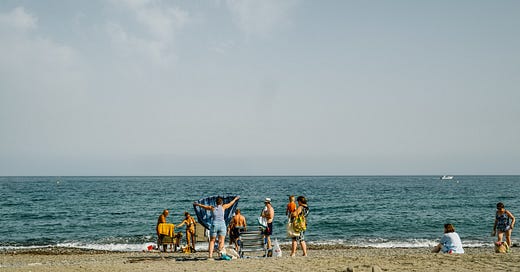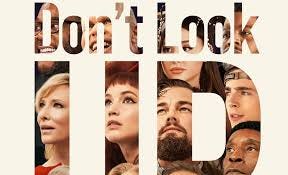The Mundane and The Magnificent
The Dance of/Rediscovering Authentic Awe in an Instagram World
It's such a Monday today.
It doesn't escape me that here I am, clothed, sheltered, and highly caffeinated - and having the luxury to sit and write about Awe & Co.
So, let's go!
No matter how hard I try, I can't get used to being alive.
Or rather, it never ceases to amaze me that against all odds, I AM. I'm not even talking about the fact that my umbilical cord was a bit too tight when I entered the world—no, I mean the sheer improbability of walking on this big piece of rock, shielded from the rest of the universe by the amniotic fluid of our atmosphere. I think about that often - then I go do laundry, clean my cats' litter box, and bitch about taxes.
Human life.
And perhaps that's the crux of our existence - this constant dance between the sublime and the mundane. The dark chocolate and the potatoes.
We build elaborate routines and fill our days with tasks, not just because they need doing, but because they help us cope with the overwhelming awareness of our own existence. We seek comfort in the ordinary precisely because the extraordinary is often too much to bear.
We're often one part scared, one part bored—or, if we look at things differently: we are often overstimulated - just mostly with the wrong stimuli.
We've largely replaced a sense of Awe with its lukewarm, sterile and politically correct version: "wellbeing." But what we truly need is not one or the other; we need mental and emotional agility to shift our perspective as needed for the job at hand.
On Being Present
I was around the dying in my life, more than once.
One would think that knowing your life is ending would make you hyperaware of things in life—from its beauty to its regrets, but while that occasionally happens, the human experience doesn't let us forget that we are in our bodies. The dying can be just as petty as everyone else. Which is actually pretty awesome.
It reminds us that being present isn't about maintaining some enlightened state of constant awareness. Sometimes being present means fully embracing our pettiness, our mundane concerns, our very human tendency to worry about small things even in the face of enormous ones. Like the characters in "Don't Look Up," we can know a comet is coming and still argue about the price of coffee or the way someone loaded the dishwasher. That's not failure - that's being alive.
Many of us get stuck in our heads, narrating our way through life. Most of it is quite silly. And while there is no comet coming (not yet), there are many other things that are.
Plus, we all know how it ends anyway.
The Death of Awe in the Age of Self
Sometimes I think we've lost something precious in our endless pursuit of self-improvement and self-image. Our sense of awe is in a bad shape since we shifted our focus to all things "self"—good and bad.
We're often so preoccupied with how we're being perceived by "others" that we've stopped paying attention to the world around us. It's the ultimate, anxiety-ridden, selfie era. We're too busy curating our image to notice the way morning light catches dewdrops on a spider's web, or how the wind creates waves in tall grass. The irony is crushing: in trying to capture every moment for others to see, we've stopped truly seeing anything at all.
The Instagramification of Wonder
There's a stark difference between experiencing awe and performing it for social media. Real awe doesn't come with a filter or a carefully crafted caption. It doesn't need validation through likes or shares. Authentic awe often catches us off guard—in moments when we're not trying to be profound or interesting or Instagram-worthy. IF we are present enough to see it.
The performative version is always ready for its closeup: the posed yoga pose at sunset, the "candid" moment of reflection beside a waterfall, the carefully arranged coffee cup next to an open journal. Don't get me wrong—these can be beautiful images. The photographer in me has the mental need to rearrange things so they look "just". As my photographer friend once told me: Don’t let reality get in the way of a good photo.
But they're often more about the performer than the wonder they're supposedly capturing. They're about being seen experiencing rather than actually experiencing. And it's usually one or the other. So watch your ratios.
Susan Sontag
Real awe, on the other hand, often leaves us speechless. It doesn't immediately reach for the phone to document the moment. Sometimes it makes us laugh, or cry, or simply stand still, forgetting ourselves entirely. That's the key—forgetting ourselves.
True awe is a vacation from the self, a brief escape from the exhausting performance of being "me."
Less Effort, More Wonder
Here's the beautiful paradox: we often don't need more motivation or effort—we need less. Less striving, less forcing, less performing. And more playfulness.
When we stop trying so hard to be creative or productive or profound, something magical happens: our natural creativity and motivation emerge on their own.
Think of children building sandcastles.
They don't need a TED talk on creativity or an Instagram guide to beach aesthetics. They don't worry about whether their castle design will get enough likes or whether it positions them as thought leaders in sandcastle architecture. They simply play. And in that play, they discover, create, and experience genuine wonder.
This is how we unlock our creativity and natural motivation—not through more productivity hacks or self-improvement strategies, but by rediscovering our capacity for unselfconscious engagement with the world. When we stop performing our experiences and start actually having them, we tap into something deeper than motivation. We find ourselves moved by curiosity, drawn forward by genuine interest rather than pushed by the need to achieve or appear.
Finding Awe in the Everyday
Awe requires attention—something we have, but in its lesser, scattered form. Awe is everywhere, at all times—and almost free, but the price might seem pretty steep for some. Because its currency is attention. We need to pay attention.
The Big Awe stops us in our tracks—it demands our attention. But the Tiny Awe is trickier—we need to slow down, look more carefully, but it's there nonetheless. From harvesting berries to watercolor painting to watching a sleeping cat, or my kid, when he was very young, peeing in the bushes with a beautiful rim light around his hair (true story, have a picture to prove). These moments of wonder exist in the spaces between our daily tasks.
When I go to get a baguette after the morning school run, nobody really wants to talk about The Big Picture much. Most are happy to grab a coffee one day to talk about The Daily Grind, but seem a bit confused when I start firing away with The Big Questions. So I finish my coffee and go back to writing.
And that's the point. We need both: the mundane, embodied existence, and the transcendent. But to access either, we sometimes must first look up from our screens, turn our gaze outward instead of endlessly inward. We need the practical wisdom of everyday life - the bullet points that help us get our shit together and file taxes on time - but we also need that wild spark of inspiration, that sense of mystery and wonder. This is where Art & Awe come in, serving as bridges between our ordinary and extraordinary experiences.
I think it's part of the reason behind the great psychedelic renaissance, too: we need awe, we need a shift in perspective, and we've lost - or forgotten - other vehicles that can get us some of it.
Plus, we still have bills to pay, careers and personas to maintain, and going for an ayahuasca retreat or chucking some gummies is faster than retreating into the mountains of Wuyishan for a couple of years. We get some awe and back to business. But what's one of the lessons they offer? Stepping outside of the confinement of our head into something much bigger; leaving our ego behind, "dying" to feel alive.
We need times when we do one big "nothing" - wander and wonder, get lost in rabbit holes, give serendipity a chance, answer the calls, get nudged, get into the dance with life - like in an improv class - finish someone else's sentences, pass it on, get into a flow state without the Pomodoro drum telling us when to focus, when to chill and just walk the backalleys of our minds; simply to see what happens.
That's tricky. That's life.
And perhaps that's the most magnificent thing of all - how we keep dancing between the mundane and the magnificent, between our tax returns and our transcendence, between cleaning the litter box and contemplating the cosmos. In this dance, we find our humanity, our humor, and ultimately, our home.
So I hope you DO look up, while watching your step.
(I promise not to turn this space into one about photography, but since we’ve optimized our existence so much about how things look instead of how they feel, here’s something you might enjoy)
* I asked myself: “what small risk am I willing to take today?” and though I’ll hit publish on this one. Now - your turn.








